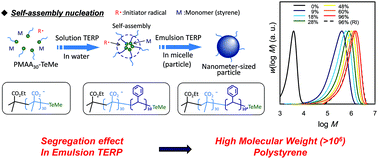A synthetic route to ultra-high molecular weight polystyrene (>106) with narrow molecular weight distribution by emulsifier-free, emulsion organotellurium-mediated living radical polymerization (emulsion TERP)†
Abstract
We propose a route to synthesizing ultra-high molecular weight (>106) polystyrene (PS) having a narrow molecular weight distribution by controlled/living radical polymerization. The process is an emulsifier-free, emulsion organotellurium-mediated living radical polymerization (emulsion TERP) using poly(methacrylic acid)-methyltellanyl as a macro-chain transfer agent with a degenerative chain transfer (DT) mechanism. Under the polymerization conditions in which PS particles were formed by a self-assembly nucleation of polymerizing macro-chain transfer agents, very stable PS particles were successfully obtained. The segregation effect in the emulsion polymerization system can suppress the radical termination reaction, resulting in an ultra-high number-average molecular weight (Mn) PS in almost 24 h under 1 atm. The final Mn value was controlled by changing the initial monomer loading (solid contents of styrene), and then PS having a Mn ∼1.2 × 106 with a low polydispersity index (∼1.3) was successfully obtained.


 Please wait while we load your content...
Please wait while we load your content...